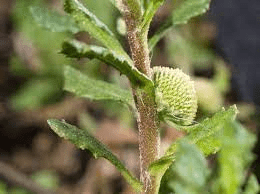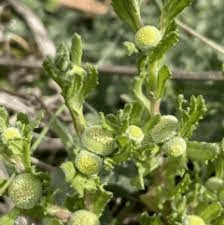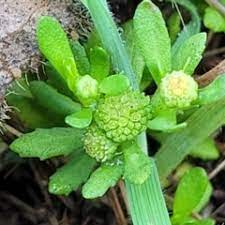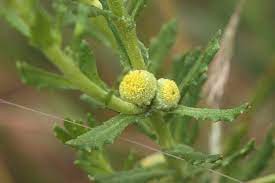Centipeda cunninghamii, commonly known as the Common Sneezeweed, is a perennial herbaceous plant that belongs to the Asteraceae family. Indigenous to Australia, this unique species is renowned for its traditional medicinal uses and its distinctive appearance in the natural landscape.
The Common Sneezeweed is a low-growing plant with a prostrate or ascending habit, typically reaching heights of 10 to 30 centimeters. Its branching stems bear linear or lance-shaped leaves that are arranged alternately along the stem. The leaves, characterized by their serrated margins, exude a strong aromatic fragrance when crushed.
One of the notable features of Centipeda cunninghamii is its remarkable adaptation to various environmental conditions. It can be found in diverse habitats, including open woodlands, grasslands, and disturbed areas. The plant’s ability to thrive in different ecosystems underscores its resilience and ecological versatility.
During the flowering season, the Common Sneezeweed displays small, daisy-like flowers with white to pale yellow petals. The flowers are arranged in terminal clusters, creating a visually appealing display. The blooming period typically occurs in late spring to early summer.
In traditional Aboriginal medicine, Centipeda cunninghamii has been utilized for its medicinal properties. Various parts of the plant, including leaves and stems, have been employed to treat ailments such as coughs, colds, and skin conditions. The plant’s association with respiratory conditions has earned it the common name “Sneezeweed.”
While traditional uses highlight its cultural importance, ongoing scientific research aims to explore the potential pharmacological properties of Centipeda cunninghamii. As a significant component of Australia’s native flora, the Common Sneezeweed contributes not only to the country’s biodiversity but also to its cultural and medicinal heritage.
The Botanical Description of Centipeda cunninghamii
1. Growth Habit: Centipeda cunninghamii is a low-growing perennial herb that typically reaches heights of 10 to 30 centimeters. Its prostrate or ascending stems create a mat-like appearance.
2. Leaves: The leaves of Centipeda cunninghamii are small, lance-shaped, and arranged oppositely along the stems. They are typically green, showcasing a simple yet elegant structure.
3. Flowers: The plant produces small, daisy-like flowers with white or pale yellow petals. These flowers are arranged in clusters at the tips of the stems, adding a delicate beauty to the herb.
4. Root System: Centipeda cunninghamii has a fibrous root system, contributing to its ability to thrive in various soil conditions. The roots play a vital role in nutrient absorption and plant stability.
5. Aroma: When the leaves of Centipeda cunninghamii are crushed, they emit a distinct aromatic fragrance. This characteristic aroma is part of the sensory experience associated with the herb.
6. Reproductive Features: The plant reproduces via both seeds and vegetative propagation. Its ability to propagate vegetatively aids in the formation of dense mats in suitable habitats.
7. Adaptations: Centipeda cunninghamii exhibits adaptations to thrive in diverse environments. Its low growth habit and ability to tolerate different soil types contribute to its ecological versatility.
8. Foliage Density: The foliage of Centipeda cunninghamii can form dense mats, providing ground cover in its natural habitat. This characteristic contributes to its ecological role and competitiveness.
9. Seasonal Changes: The plant may exhibit seasonal changes in growth and flowering, responding to environmental cues such as temperature and daylight duration.
10. Ecological Interactions: Centipeda cunninghamii interacts with various organisms in its ecosystem. It may serve as a habitat for small insects and contribute to soil health through its root system.
The Geographic Distribution of Centipeda cunninghamii

1. Native Range: Centipeda cunninghamii is native to Australia, where it is found in various regions across different states. Its distribution spans from coastal areas to inland regions.
2. Habitat Preferences: The herb is adaptable to a range of habitats, including open woodlands, heathlands, and grasslands. It thrives in well-drained soils and is often encountered in areas with ample sunlight.
3. Australian States: Centipeda cunninghamii is reported in states such as New South Wales, Queensland, Victoria, and South Australia. Its distribution within these states may vary based on local environmental conditions.
4. Coastal Presence: The plant is known to occur in coastal areas, where its low-growing habit and adaptability contribute to its ability to colonize sandy or rocky substrates.
5. Altitudinal Range: Centipeda cunninghamii can be found at various altitudes, from coastal plains to elevated areas. Its distribution across different elevations showcases its ecological resilience.
6. Global Distribution: While native to Australia, Centipeda cunninghamii has also been introduced to other parts of the world, including parts of Asia. The plant’s adaptability may contribute to its presence beyond its native range.
7. Soil Types: The herb demonstrates adaptability to different soil types, including sandy soils and loamy substrates. This adaptability enhances its ability to establish populations in various environments.
8. Human-Induced Changes: Human activities, including land use changes and habitat disturbances, can influence the distribution of Centipeda cunninghamii. The plant may colonize disturbed areas or face challenges in altered landscapes.
9. Conservation Status: The conservation status of Centipeda cunninghamii may vary in different regions. Monitoring and understanding its distribution contribute to conservation efforts, especially in areas facing environmental pressures.
10. Ecological Role: Centipeda cunninghamii plays a role in local ecosystems by contributing to ground cover, providing habitat for small organisms, and participating in nutrient cycling in its natural habitat.
The Chemical Composition of Centipeda cunninghamii
1. Essential Oils: Centipeda cunninghamii is known to contain essential oils, which contribute to its aromatic properties. These oils may have potential applications in traditional medicine or aromatherapy.
2. Terpenoids: The chemical composition includes terpenoids, which are organic compounds with diverse biological activities. Terpenoids may contribute to the plant’s medicinal properties.
3. Flavonoids: Flavonoids, a group of polyphenolic compounds, are present in Centipeda cunninghamii. These compounds have antioxidant properties and may play a role in the herb’s potential health benefits.
4. Alkaloids: Some species within the Centipeda genus are reported to contain alkaloids. Alkaloids are nitrogen-containing compounds with pharmacological significance.
5. Phenolic Compounds: Centipeda cunninghamii may contain phenolic compounds, which have antioxidant and anti-inflammatory properties. These compounds contribute to the overall chemical profile of the plant.
6. Tannins: Tannins, known for their astringent properties, are part of the chemical composition of Centipeda cunninghamii. Tannins may have implications for the herb’s medicinal uses.
7. Saponins: Presence of saponins, glycoside compounds with soap-like properties, adds to the chemical diversity of Centipeda cunninghamii. Saponins can have various biological activities.
8. Lignans: Lignans, compounds with potential antioxidant and anti-inflammatory effects, may be found in Centipeda cunninghamii. These contribute to the herb’s pharmacological profile.
9. Antimicrobial Compounds: Some components of Centipeda cunninghamii may possess antimicrobial properties, which could be relevant in traditional medicine and natural health practices.
10. Variation in Composition: The chemical composition of Centipeda cunninghamii may exhibit variations based on factors such as geographic location, environmental conditions, and genetic diversity within populations.
11. Potential Bioactive Compounds: Ongoing research aims to identify specific bioactive compounds in Centipeda cunninghamii, unraveling their potential health benefits and therapeutic applications.
12. Pharmacological Significance: Understanding the chemical composition of Centipeda cunninghamii is crucial for unlocking its pharmacological significance and exploring its potential contributions to healthcare and wellness.
13. Traditional Uses: Traditional uses of Centipeda cunninghamii often involve extracting medicinal properties from its chemical components. Indigenous knowledge may provide insights into the plant’s applications.
14. Interactions with Other Species: The chemical composition of Centipeda cunninghamii may influence its interactions with other species in its ecosystem, including herbivores, insects, and soil microorganisms.
15. Sustainable Harvesting: Considerations for sustainable harvesting of Centipeda cunninghamii should involve understanding its chemical composition, ensuring responsible practices that maintain ecological balance.
Read Also: 17 Medicinal Health Benefits Of Iris leptophylla (Slender-Leaf Iris)
The Medicinal Health Benefits Of Centipeda cunninghamii (Common Sneezeweed)

1. Anti-Inflammatory Properties: Centipeda cunninghamii is renowned for its anti-inflammatory properties, making it a valuable herb in traditional medicine for addressing inflammatory conditions.
2. Respiratory Health: The herb is traditionally used to support respiratory health, with potential benefits for conditions such as coughs, colds, and respiratory congestion.
3. Skin Conditions: Centipeda cunninghamii may offer relief for various skin conditions, including irritations and minor wounds, attributed to its anti-inflammatory and soothing effects.
4. Digestive Support: Traditional uses include digestive support, with the herb believed to aid in soothing digestive discomfort and promoting overall gastrointestinal well-being.
5. Immune System Support: The herb is valued for its potential to support the immune system, contributing to the body’s natural defenses against infections and illnesses.
6. Antioxidant Benefits: Centipeda cunninghamii’s antioxidant properties may help combat oxidative stress, protecting cells from damage caused by free radicals.
7. Anti-Microbial Effects: Traditional applications involve the herb’s antimicrobial effects, suggesting potential benefits in addressing microbial infections.
8. Stress Relief: Centipeda cunninghamii may have adaptogenic properties, helping the body cope with stress and promoting a sense of calm.
9. Anti-Allergic Effects: Some traditional uses include managing allergic reactions, with the herb believed to have anti-allergic effects.
10. Pain Management: Centipeda cunninghamii is traditionally used for pain management, offering relief from conditions such as headaches or muscle discomfort.
11. Menstrual Support: Traditional applications include providing support for menstrual health, potentially alleviating symptoms associated with the menstrual cycle.
12. Detoxification: The herb may play a role in supporting natural detoxification processes within the body, contributing to overall wellness.
13. Cardiovascular Health: Some traditional uses suggest benefits for cardiovascular health, potentially influencing factors such as blood circulation and cholesterol levels.
14. Anti-Anxiety Properties: Centipeda cunninghamii may have calming effects, making it a potential remedy for individuals dealing with anxiety or nervousness.
15. Traditional Wisdom: The medicinal health benefits of Centipeda cunninghamii are deeply rooted in traditional wisdom, passed down through generations in various cultures.
16. Holistic Wellness: The diverse range of medicinal benefits underscores the herb’s potential role in promoting holistic wellness, addressing multiple aspects of health.
The Methods of Usage to Achieve the Provided Health Benefits Of Centipeda cunninghamii (Common Sneezeweed)
1. Infusions and Teas: One common method is preparing infusions or teas using Centipeda cunninghamii leaves. This allows for the extraction of beneficial compounds for respiratory and digestive health.
2. Topical Applications: For skin conditions and minor wounds, creating poultices or applying infused oils made from Centipeda cunninghamii can provide targeted relief.
3. Inhalation: Inhaling steam infused with Centipeda cunninghamii essential oils may offer respiratory benefits, making it a method for addressing congestion or respiratory discomfort.
4. Tinctures and Extracts: Tinctures and liquid extracts provide concentrated forms of Centipeda cunninghamii, allowing for easy incorporation into wellness routines for immune system support.
5. Capsules and Supplements: For those seeking a convenient option, capsules or supplements containing Centipeda cunninghamii extracts offer a measured and controlled dosage.
6. Culinary Uses: In cultures where it is traditionally consumed, incorporating Centipeda cunninghamii into culinary preparations, such as soups or stews, provides both flavor and potential health benefits.
7. Aromatherapy: Diffusing essential oils extracted from Centipeda cunninghamii may contribute to stress relief and relaxation, supporting mental well-being.
8. Compresses: Applying compresses soaked in Centipeda cunninghamii infusions or decoctions to specific areas may offer localized relief, such as for muscle discomfort.
9. Bath Additives: Adding Centipeda cunninghamii extracts to baths provides a relaxing experience while potentially benefiting skin health.
10. Gargles and Mouthwashes: For oral health, preparing gargles or mouthwashes with Centipeda cunninghamii infusions may offer antimicrobial and soothing effects.
11. Traditional Formulations: Respecting traditional knowledge, following specific formulations recommended in traditional medicine ensures the appropriate balance of ingredients for desired health benefits.
12. Professional Guidance: Seeking guidance from herbalists, traditional medicine practitioners, or healthcare professionals ensures safe and effective methods of using Centipeda cunninghamii for health benefits.
The Side Effects Of Using Centipeda cunninghamii Medicinal Plant
1. Allergic Reactions: Some individuals may experience allergic reactions to Centipeda cunninghamii, presenting as skin rashes, itching, or respiratory symptoms. Discontinue use if allergic responses occur and seek medical advice.
2. Gastrointestinal Discomfort: Ingesting large quantities of Centipeda cunninghamii preparations may lead to gastrointestinal discomfort, including nausea or upset stomach. Adhering to recommended dosages minimizes this risk.
3. Photosensitivity: Certain compounds in Centipeda cunninghamii may increase sensitivity to sunlight. Users should be cautious about prolonged sun exposure and consider sun protection measures.
4. Interaction with Medications: Centipeda cunninghamii supplements may interact with certain medications. Individuals taking prescription drugs should consult healthcare professionals before incorporating the herb into their regimen.
5. Pregnancy and Lactation: Pregnant and lactating individuals should exercise caution when using Centipeda cunninghamii medicinally. Limited research exists on its safety in these circumstances, warranting professional advice.
6. Not Suitable for Pets: Centipeda cunninghamii may be toxic to pets if ingested. Pet owners should keep the plant out of reach of animals to prevent potential harm.
7. Diuretic Effects: Some individuals may experience mild diuretic effects when using
Centipeda cunninghamii, potentially leading to increased urination. Individuals sensitive to diuretics or those with certain medical conditions should be mindful of this effect.
8. Potential Blood Pressure Effects: The herb’s influence on blood pressure may vary among individuals. Those with existing blood pressure concerns should exercise caution and monitor their blood pressure regularly.
9. Not Recommended for Children: Due to limited research on the effects of Centipeda cunninghamii on children, it is not recommended for use in this population. Safety considerations should prioritize the well-being of developing physiology.
10. Adverse Effects on Liver: Excessive or prolonged use of certain herbal preparations, including Centipeda cunninghamii, may pose risks to liver health. Monitoring for signs of liver issues, such as jaundice or abdominal pain, is crucial.
11. Potential Interactions with Other Herbs: Centipeda cunninghamii may interact with other herbs or supplements. Individuals using multiple herbal remedies should consult healthcare professionals to avoid potential interactions.
12. Effects on Fertility: Limited information exists on the impact of Centipeda cunninghamii on fertility. Individuals trying to conceive or with fertility concerns should seek professional advice before using the herb.
13. Tolerance and Dependence: Prolonged or excessive use of Centipeda cunninghamii may lead to tolerance or dependence. It is advisable to take breaks in usage and assess its ongoing efficacy.
14. Respiratory Sensitivity: Individuals with respiratory conditions should be cautious when using Centipeda cunninghamii, as its inhalation in certain forms may trigger respiratory sensitivity.
Read Also: 15 Medicinal Health Benefits Of Comfrey (Symphytum officinale)
The Scientific Research and Studies of Centipeda cunninghamii

1. Anti-Inflammatory Studies: Scientific research has explored the anti-inflammatory properties of Centipeda cunninghamii, with studies indicating its potential in modulating inflammatory responses.
2. Antimicrobial Activity: Investigations into the plant’s antimicrobial activity have identified compounds that exhibit inhibitory effects against various microorganisms, highlighting its potential in addressing infections.
3. Immunomodulatory Effects: Research suggests that Centipeda cunninghamii may possess immunomodulatory effects, influencing the immune system’s response and potentially enhancing overall immune function.
4. Antioxidant Capacity: Studies have evaluated the antioxidant capacity of Centipeda cunninghamii, indicating its ability to neutralize free radicals and mitigate oxidative stress.
5. Respiratory Health Benefits: Scientific interest in the plant’s traditional use for respiratory conditions has led to studies exploring its effectiveness in addressing issues such as coughs and congestion.
6. Wound Healing Properties: Some research has investigated the wound healing properties of Centipeda cunninghamii, attributing its potential to accelerate the healing process and reduce inflammation.
7. Analgesic Effects: Studies suggest that the herb may have analgesic effects, providing relief from pain and discomfort. The mechanisms behind these effects are areas of ongoing research.
8. Skin Health Applications: Scientific exploration of Centipeda cunninghamii’s effects on the skin includes research on its anti-inflammatory and soothing properties, supporting its traditional uses for skin conditions.
The Safety Precautions and Recommendations In Using Centipeda cunninghamii Medicinal Plant
1. Consultation with Healthcare Professionals: Before incorporating Centipeda cunninghamii into any health regimen, individuals should consult with healthcare professionals, especially those with pre-existing health conditions or taking medications.
2. Allergy Testing: Conducting a patch test or trying a small amount of Centipeda cunninghamii preparation before regular use helps identify potential allergic reactions. Discontinue use if any adverse reactions occur.
3. Dosage Adherence: Adhering to recommended dosages and usage guidelines is crucial to prevent adverse effects. Excessive or prolonged use may lead to unwanted consequences.
4. Pregnancy and Lactation Caution: Pregnant and lactating individuals should exercise caution and seek professional advice before using Centipeda cunninghamii. Limited research exists on its safety in these circumstances.
5. Interaction with Medications: Individuals on prescription medications should consult healthcare providers to rule out potential interactions with Centipeda cunninghamii. This precaution prevents compromised medication efficacy or unwanted effects.
6. Avoiding Prolonged Use: To prevent tolerance or dependence, avoiding prolonged or excessive use of Centipeda cunninghamii is advisable. Periodic breaks in usage and assessing its ongoing efficacy are prudent practices.
7. Sun Protection Measures: Individuals using Centipeda cunninghamii topically should be aware of potential photosensitivity. Employing sun protection measures, such as sunscreen, can help minimize the risk of sun-related issues.
8. Pets and Plant Safety: In households with pets, ensuring that Centipeda cunninghamii is kept out of reach of animals is essential. The plant may be toxic to pets if ingested. Pet owners should prioritize their animals’ safety.
9. Children and Centipeda cunninghamii: Due to limited research on the effects of Centipeda cunninghamii on children, it is not recommended for use in this population. Safety considerations should prioritize the well-being of developing physiology.
10. Balanced Approach to Health: Centipeda cunninghamii should be viewed as part of a balanced approach to health, including a varied diet, regular exercise, and other wellness practices. It is not a standalone solution and works best within a holistic lifestyle.
11. Quality of Supplements: For individuals using Centipeda cunninghamii supplements, ensuring the quality and purity of the product is essential. Choosing reputable brands and products that undergo testing for contaminants guarantees a safer experience.
FAQs About Centipeda cunninghamii Medicinal Plant
1. What is Centipeda cunninghamii commonly used for in traditional medicine?
Centipeda cunninghamii is traditionally used for various health purposes, including anti-inflammatory support, respiratory health, and skin conditions. Its applications are diverse across different cultures.
2. Can Centipeda cunninghamii be grown in home gardens?
Yes, Centipeda cunninghamii can be cultivated in home gardens, provided suitable growing conditions such as well-drained soil and ample sunlight are available.
3. Are there different varieties of Centipeda cunninghamii with unique characteristics?
Centipeda cunninghamii is a species, and variations within the species may exist. However, specific cultivars with distinct characteristics are not widely recognized.
4. How can I address potential allergic reactions to Centipeda cunninghamii?
If allergic reactions occur, such as skin rashes or respiratory symptoms, discontinuing use is crucial. Seeking medical attention for severe reactions and consulting healthcare professionals for guidance on alternative remedies is advisable.
5. Can Centipeda cunninghamii be used as a substitute for professional medical treatment?
No, Centipeda cunninghamii should not be used as a substitute for professional medical treatment or diagnosis. It can complement a healthy lifestyle but should not replace consultation with healthcare providers for specific health concerns.
6. What precautions should be taken when using Centipeda cunninghamii topically?
Precautions include performing a patch test to check for sensitivity, avoiding prolonged sun exposure due to potential photosensitivity, and using sun protection measures. If adverse reactions occur, discontinuing use is recommended.
7. Is Centipeda cunninghamii safe for use in culinary preparations?
While it is traditionally consumed in some cultures, using Centipeda cunninghamii in culinary preparations should be approached with caution. Adhering to traditional practices and consulting knowledgeable sources is advisable.
8. How can individuals incorporate Centipeda cunninghamii into a holistic wellness routine?
Incorporation methods include preparing teas, using extracts or tinctures, adding it to culinary dishes, or using infused oils. Professional guidance ensures safe and effective integration into a wellness routine.
9. Can pregnant or lactating individuals use Centipeda cunninghamii?
Pregnant or lactating individuals should exercise caution and seek professional advice before using Centipeda cunninghamii due to limited research on its safety in these circumstances.
10. What scientific research supports the health benefits of Centipeda cunninghamii?
Scientific studies have explored the anti-inflammatory, antimicrobial, immunomodulatory, and antioxidant properties of Centipeda cunninghamii. Ongoing research aims to further understand its potential health benefits.
11. Are there any known contraindications with specific medications and Centipeda cunninghamii?
Centipeda cunninghamii supplements may interact with certain medications. Consultation with healthcare professionals is crucial to prevent potential interactions and ensure safety.
12. How can individuals ensure the quality of Centipeda cunninghamii supplements?
Choosing supplements from reputable brands that undergo testing for purity and contaminants ensures the quality of Centipeda cunninghamii products. Reading customer reviews and seeking recommendations can guide product selection.
13. Is Centipeda cunninghamii suitable for pets?
Centipeda cunninghamii may be toxic to pets if ingested. Pet owners should keep the plant out of reach of animals to prevent potential harm. If accidental ingestion occurs, seeking veterinary advice is recommended.
14. Can Centipeda cunninghamii be used in combination with other herbal remedies?
While combinations of herbal remedies are common, consulting with healthcare professionals ensures safe combinations and avoids potential interactions between different herbs.
15. How can individuals contribute to the sustainable harvesting of Centipeda cunninghamii?
Sustainable harvesting involves respecting natural habitats, adhering to regulations, and avoiding overharvesting. Supporting ethical sourcing practices and cultivation initiatives contributes to the plant’s conservation.
16. Is there ongoing research on Centipeda cunninghamii?
Yes, ongoing research aims to explore the full range of health benefits, chemical composition, and potential applications of Centipeda cunninghamii. Scientific inquiry continues to expand our understanding of this medicinal plant.
Read Also: How to Start an Urban Farm

